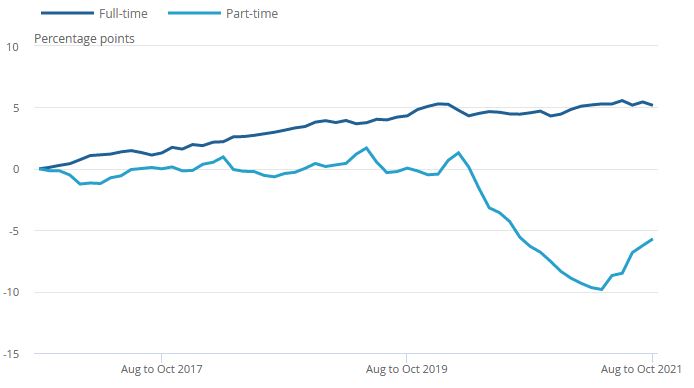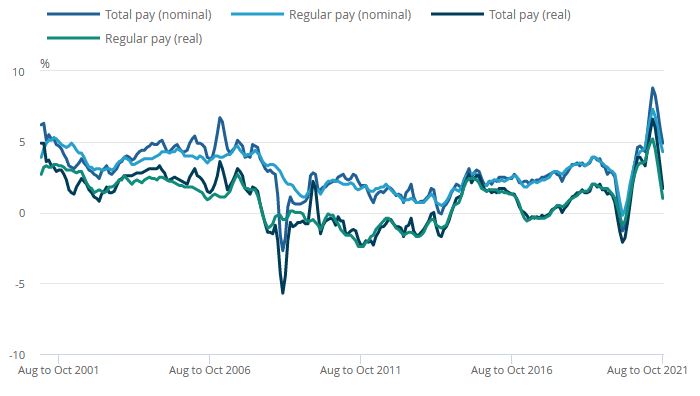ONS Labour Market December 2021
Record high job vacancies
- Job vacancies rose to yet another record high, with 13 of the 18 industry sectors showing new record highs.
- Between September and November, the estimated number of vacancies hit 1,219,000 – an increase of 434,500 from the pre-coronavirus January to March 2020 level.
- However, the rate of growth has slowed to 17.9% between September and November, from 35.4% in the previous quarter.
Part-time employment rises
- Early payroll estimates for November show the number of payrolled employees rose by 4.8% year-on-year, or 1,353,000 employees. This is almost half a million (424,000) more than pre-Covid levels, with the number of payrolled employees up by 1.5% since February 2020.
- All age groups saw an increase in payrolled employees in the year to November 2021, with those aged under 25 years old seeing an increase of 564,000 payrolled employees.
- The largest yearly increases in payrolled employees continued to be in the administrative and support services sector (a rise of 290,000 employees), while smallest in the transportation and storage sector (a fall of 9,000).
UK employment by full-time and part-time workers (aged 16 years and over), seasonally adjusted, cumulative change from August to October 2016, for each period up to August to October 2021

Source: Office for National Statistics – Labour Force Survey
- On the wider survey measure of employment, the employment rate remained 1.1 percentage points down on pre-pandemic levels at 75.5% in the quarter to October. However, this marked a 0.2 percentage point uplift on the previous quarter to July.
- The number of part-time workers decreased strongly during the pandemic, but has been increasing since April to June 2021, driving the quarterly increase in employment.
- Young people (those aged 16 to 24 years) have been particularly affected by the pandemic. Over the last quarter however, there was an increase in the employment rate and a decrease in the unemployment rate to below pre-coronavirus rates.
Unemployment falls to 4.2%
- The latest unemployment estimates show a 0.4 percentage point drop on the previous quarter to 4.2% in the three months to October. This is 0.2 percentage points higher than before the pandemic.
- The quarterly decrease in unemployment was driven by those unemployed for up to 12 months. However, the long-term unemployment saw its first quarterly decrease since May to July 2020.
Hours worked edges up
- In the three months to October, total actual weekly hours worked increased by 17.6 million hours from the previous quarter to 1.02 billion hours.
- However, the rate of increase is slowing and is still 27.8 million hours below pre-coronavirus levels.
Earnings squeeze
Annual pay continued to increase in the three months to October. In nominal terms:
- Average regular pay (excluding bonuses) for employees in Great Britain was £548 per week before tax and other deductions from pay – up from £528 per week a year earlier.
- Average total pay (including bonuses) for employees in Great Britain was £586 per week before tax and other deductions from pay – up from £563 per week a year earlier.
- Regular and total pay growth rose by 4.3% and 4.9% respectively in the three months to October compared to a year earlier.
- In real terms (adjusted for inflation), regular and total pay are growing at 1.0% and 1.7% respectively.
It should be noted that:
- Previous months' strong growth rates have been affected by base and compositional effects. These temporary factors have largely worked their way out of the latest growth rates, but a small amount of base effect for certain sectors may still be present.
Great Britain, average weekly earnings annual growth rates, January to March 2001 to July to September 2021

Source: ONS
Back to Retail Economic News